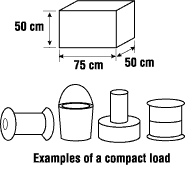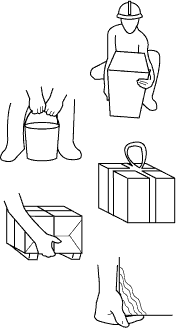MMH - Compact Loads
On this page
How should a compact load be lifted?
Back to topA compact load can be lifted between the knees.

When lifting, remember to:
- Look and plan ahead. Make sure your path is free of obstructions.
- Stand close behind the load.
- Check that you can get a good grip on the load.
- Wear gloves, if necessary, to prevent scrapes or bruises.
- Straddle the load:
- Place the leading foot flat beside the load in the direction of travel.
- Place the rear in the direction of travel.
- Bend the hips and knees.
- Keep your back straight.
- Grasp the load with elbows inside the thighs:
- Use a power grasp for loads with handles.
- Use slings or hooks to improve grasp when loads do not have handles.
- Use blocks under loads without handles to make lifting them up easier and safer.
- Use a ledge grasp for loads without handles.

- Grasp with one hand at the outer, upper corner, over the leading foot and the other hand on the lower, opposite corner.
- Lean forward with the rear arm straight. This position gets the load moving.
- Stand up by thrusting off with the back leg and continuing in an upward and forward direction.
- Keep the load close to the body.
- Use your thigh and leg muscles, not your back, as you lift in one, smooth motion.
- Keep the rear arm straight.
- Move off without twisting the body.
- Keep the load at a reasonable height so you can see where you are going.

What should be remembered when putting a load down?
Back to top- Take a wide stance with one foot in front of the other.
- Keep the load close to the body.
- Keep the back straight.
- Bend the hips and knees.
- Set the load down onto the ground.
- Keep the load tilted to avoid bruising fingers.
- Remove fingers from under the load.
- Stand up smoothly, easing muscles.
- Avoid jerky releases.
- Fact sheet confirmed current: 2021-02-01
- Fact sheet last revised: 2009-07-06

